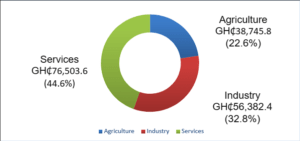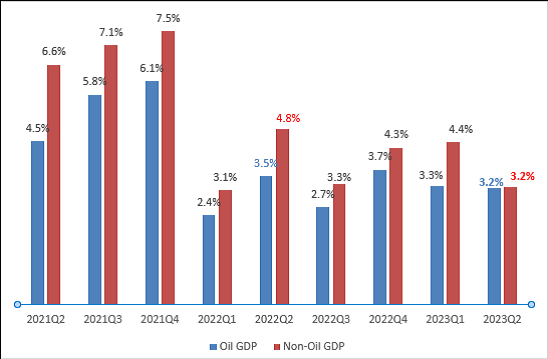Economic growth moderated during the second quarter of 2023, primarily slowed by the implementation of front-loaded fiscal consolidation measures and the adoption of a cautious monetary policy stance.
According to data released by the Ghana Statistical Service, the provisional real gross domestic product (GDP) growth rate – which includes contributions from the oil and gas sector – decelerated to 3.2 percent year-on-year in Q2 2023. This figure was in contrast to the 3.5 percent recorded during the same period of 2022 and a revised 3.3 percent growth in Q1 2023.
In tandem with this trend, the non-oil GDP growth rate for second-quarter 2023 also registered a slowdown – standing at 3.2 percent. This figure represents a decline from the 4.8 percent growth observed in second-quarter 2022 and a revised 4.4 percent growth in Q1 2023. This deceleration of economic activity was widely anticipated, primarily attributed to ongoing fiscal consolidation efforts and the tightened monetary stance aimed at addressing elevated inflationary pressures.
As the nation embarked on the path of front-loaded fiscal consolidation, the private sector was expected to be the primary catalyst for economic growth. However, credit growth in 2023 faced constraints as banks adopted a cautious approach – partially due to challenges emanating from the Domestic Debt Exchange Programme (DDEP).
Consequently, despite experiencing positive growth in first-quarter 2023, market analysts remain cautious regarding the economic outlook. They attribute this caution to austerity measures outlined in the IMF programme and the potential for a more restrictive monetary policy stance that could further exacerbate challenges facing the private sector, particularly with regard to accessing credit. These factors collectively have the potential to dampen overall economic activity within the real sector.

An examination of the real quarterly GDP figures for second-quarter 2023 reveals that the real GDP – including the oil & gas sector – reached GH¢42.11billion, marking an increase from the GH¢40.8billion recorded in second-quarter 2022. Simultaneously, the real non-oil GDP for the same period of 2023 amounted to approximately GH¢39.70billion; up from GH¢38.46billion in second-quarter 2022.
In the sectoral breakdown, the services sector exhibited the most robust growth – expanding by 6.3 percent. Following closely was the agriculture sector which posted a growth rate of 6.0 percent, while the industry sector saw a contraction with a negative growth rate of -1.9 percent. The services sector continued to assert its dominance in the economy, contributing 44.6 percent of GDP at basic prices. The GDP shares for industry and agriculture were 32.8 percent and 22.6 percent respectively.
Sectoral analysis
Within the agriculture sector, which recorded a growth rate of 1.3 percent in second-quarter 2023 (compared to 2.0 percent in the first quarter), the livestock sub-sector experienced a slight decline of 0.2 percentage points. Additionally, the crops and cocoa sub-sector’s growth rate declined by 0.7 percentage points; growing at 1.3 percent in the second quarter compared to 2.0 percent in the first quarter.
However, the fishing sub-sector exhibited signs of improvement – growing at 2.8 percent in the second quarter after contracting by -0.7 percent in the first quarter. The forestry and logging sub-sector meanwhile faced a marginal decline of 0.7 percentage points.
Within the industry sector, which contracted by -0.4 percent quarter-on-quarter, the mining and quarry sub-sector displayed marginal improvement by shifting from a -0.5 percent contraction in first-quarter 2023 to a growth rate of 0.8 percent in the second quarter.
In contrast, the electricity subsector experienced a decline from 0.9 percent in first-quarter 2023 to -1.2 percent in the second quarter. The manufacturing sub-sector exhibited minimal improvement, moving from -0.4 percent in the first quarter to -0.1 percent in the second quarter. Other sub-sectors – such as water supply, sewerage, waste management and remediation activities, and construction – encountered their share of challenges.
In the services sector, the information and communication sub-sector displayed robust growth; increasing from 4.7 percent in first-quarter 2023 to 5.6 percent in the second quarter. Health, on the other hand, recorded a marginal decline by growing at 2.9 percent in second-quarter 2023, down from 3.0 percent in the first quarter.
Public administration, defence, social security and education also experienced lower growth rates in the second quarter compared to the first quarter. Finance & Insurance activities witnessed a significant decline of 1.9 percentage points, dropping from 2.0 percent growth in the first quarter to 0.1 percent in the second quarter. Transport, storage and real estate also recorded slower growth rates in the second quarter.
Trade, repair of vehicles and household goods experienced a decline to -0.9 percent in second-quarter 2023 from 0.9 percent in the first quarter, indicating challenges in the retail and repair sectors.










